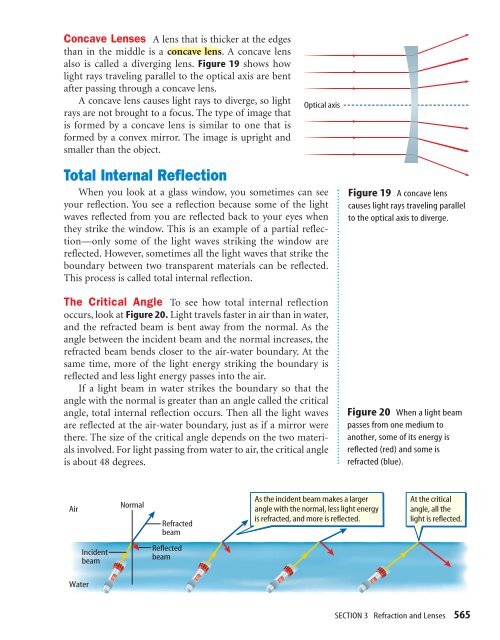Light Mirrors and Lenses (3379.0K) - McGraw-Hill Higher Education
Light Mirrors and Lenses (3379.0K) - McGraw-Hill Higher Education
Light Mirrors and Lenses (3379.0K) - McGraw-Hill Higher Education
- No tags were found...
Create successful ePaper yourself
Turn your PDF publications into a flip-book with our unique Google optimized e-Paper software.
Concave <strong>Lenses</strong> A lens that is thicker at the edgesthan in the middle is a concave lens. A concave lensalso is called a diverging lens. Figure 19 shows howlight rays traveling parallel to the optical axis are bentafter passing through a concave lens.A concave lens causes light rays to diverge, so lightrays are not brought to a focus. The type of image thatis formed by a concave lens is similar to one that isformed by a convex mirror. The image is upright <strong>and</strong>smaller than the object.Optical axisTotal Internal ReflectionWhen you look at a glass window, you sometimes can seeyour reflection. You see a reflection because some of the lightwaves reflected from you are reflected back to your eyes whenthey strike the window. This is an example of a partial reflection—onlysome of the light waves striking the window arereflected. However, sometimes all the light waves that strike theboundary between two transparent materials can be reflected.This process is called total internal reflection.The Critical Angle To see how total internal reflectionoccurs, look at Figure 20. <strong>Light</strong> travels faster in air than in water,<strong>and</strong> the refracted beam is bent away from the normal. As theangle between the incident beam <strong>and</strong> the normal increases, therefracted beam bends closer to the air-water boundary. At thesame time, more of the light energy striking the boundary isreflected <strong>and</strong> less light energy passes into the air.If a light beam in water strikes the boundary so that theangle with the normal is greater than an angle called the criticalangle, total internal reflection occurs. Then all the light wavesare reflected at the air-water boundary, just as if a mirror werethere. The size of the critical angle depends on the two materialsinvolved. For light passing from water to air, the critical angleis about 48 degrees.Figure 19 A concave lenscauses light rays traveling parallelto the optical axis to diverge.Figure 20 When a light beampasses from one medium toanother, some of its energy isreflected (red) <strong>and</strong> some isrefracted (blue).AirNormalRefractedbeamAs the incident beam makes a largerangle with the normal, less light energyis refracted, <strong>and</strong> more is reflected.At the criticalangle, all thelight is reflected.IncidentbeamReflectedbeamWaterSECTION 3 Refraction <strong>and</strong> <strong>Lenses</strong> 565

















